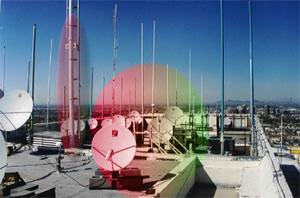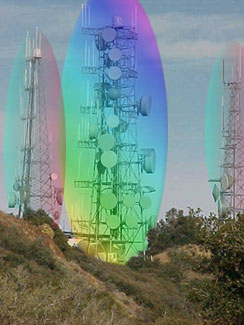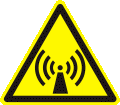
Service Information
RF Compliance Studies
Radio Frequency (RF) emission studies are required of telecommunications providers to ensure that their sites do not present a health risk. Site evaluations for Electromagnetic Energy (EME) emitted from both rooftop and tower sites must be evaluated relative to the Federal Communications Commission (FCC) rules for human exposure to RF radiation and to the Occupational Safety & Health Administration (OSHA) guidelines for safe work practices.
The FCC's Office of Engineering and Technology (OET) Bulletin 65 "Evaluating Compliance with FCC Guidelines for Human Exposure to Radio Frequency Electromagnetic Fields" is available to provide assistance in determining whether proposed and existing transmitting facilities, operations and devices comply with limits for human  exposure to RF fields. OET Bulletin 65 provides examples and explains how to perform evaluations. Exposure zones on towers must be addressed. exposure to RF fields. OET Bulletin 65 provides examples and explains how to perform evaluations. Exposure zones on towers must be addressed.
The FCC has established Maximum Permissible Exposure (MPE) limits for the general public (uncontrolled environment) in addition to individuals hired to work in an RF environment (controlled). In areas that have less than 100% MPE a trained employee can spend an unlimited amount of time. When there is more than 20% MPE the general public may have unrestricted access. When these levels are exceeded, the FCC and OSHA require employers to ensure safe working environments for their employees.
Although Bulletin 65 offers guidelines and suggestions for evaluating compliance, it is not intended to establish mandatory procedures. Other methods and procedures may be acceptable if based upon sound engineering practices. Documentation of the RF environment is required for each new and established site. If a licensee contributes 5% of their MPE to an area that is not in compliance then fines can be levied and an immediate corrective active will be required. If a tenant is 5% of the problem they will be enjoined in the fine and remediation action.
A site evaluation provided by a specialized engineering firm will provide a comprehensive EME site audit that includes an on-site  survey, measurements, modeling, analysis, reporting and a site safety plan certified by a PE. The compliance study and report will allow telecommunications carriers, building owners and property manager to provide safe work environments for their employees and the general public on rooftops, towers and inside of buildings. These must be maintained on site. Proper signage must be displayed. A site safety plan should contain measures to identify IRF areas and specific steps to ensure the safety of the general population and a safe working environment for employees of all companies. This plan may be located at the rooftop egress or maintained by the firm managing the rooftop. It should be carefully reviewed and understood by anyone accessing the site. It should provide you with the measures to take, listing any areas that should be avoided or entered only with a RF monitor. Tower safety plans must be maintained in a secure area within the compound. survey, measurements, modeling, analysis, reporting and a site safety plan certified by a PE. The compliance study and report will allow telecommunications carriers, building owners and property manager to provide safe work environments for their employees and the general public on rooftops, towers and inside of buildings. These must be maintained on site. Proper signage must be displayed. A site safety plan should contain measures to identify IRF areas and specific steps to ensure the safety of the general population and a safe working environment for employees of all companies. This plan may be located at the rooftop egress or maintained by the firm managing the rooftop. It should be carefully reviewed and understood by anyone accessing the site. It should provide you with the measures to take, listing any areas that should be avoided or entered only with a RF monitor. Tower safety plans must be maintained in a secure area within the compound.
Local governments can request compliance documentation. All RF carriers must be included in the evaluation; including cellular, PCS, SMR, paging, Part 15, Wi-Fi and in-building systems.
By complying with the FCC rules, license holders will protect  themselves from litigation, avoiding costly legal actions and the expense of correcting sites found to be unsafe and non-compliant. More importantly, however, it ensures that the environment is safe for employees and the general public. themselves from litigation, avoiding costly legal actions and the expense of correcting sites found to be unsafe and non-compliant. More importantly, however, it ensures that the environment is safe for employees and the general public.
The areas around the base of the tower can be brought into FCC compliance by the owner or license holder by obtaining a tower emissions certification letter without a site visit having to be performed.
By calculating the MPE at the base of the tower, assuming worst case ERP, the calculated results can demonstrate site compliance with respect to on ground general population limits. On structure compliance will often include site safety recommendations by the consulting firm which can include warning signage, wearing of RF monitors, personal protection equipment and controlled access guidelines.
Overexposure symptoms mirror flu
Severe cases of over RF exposure such as nausea and headaches are often mistaken for the flu. They can also have the same effect as heat stroke. The first indication is an overall feeling of warmth. Then, symptoms similar to overexertion will be noticed such as perspiration, an elevated body temperature and labored breathing. High levels of exposure over a few minutes can make you sick or even cause permanent damage.
Minimum guidelines for working in radio frequency environments in excess of the general population limits:
- Personnel should have electromagnetic energy (EME) awareness training
- Personnel entering a site must be authorized
- Personnel should obey all posted signs
- They must assume that all antennas are active
- Before working on antennas, they should notify owners and disable the appropriate transmitters by providing an acceptable lock-out-tag-out
- They must not stop in front of antennas
- Personal RF monitors must be worn while working near antennas
- Transmitters must not be operated without shields during normal operation
- Base station antennas should not be operated in an equipment room
For additional information regarding radio frequency safety, visit RF Safety .
New non-ionization radiation safety standard near approval
North Carolina's non-ionization radiation safety standard, expected to be approved during the 2006 legislative session, may be adopted by other state OSH programs as their standard. For additional information, see New NC Safety Standard.
FCC has voluntary guide to assess siting requests
The Federal Communications Commission (FCC) and its Local and State Government Advisory Committee (LSGAC) have prepared a voluntary guide to assist state and local governments in devising efficient procedures for ensuring that the antenna facilities located in their communities comply with the FCC’s limits for human exposure to radiofrequency (RF) electromagnetic fields. State and local government officials, carriers and citizens frequently consult this guide when addressing issues of facilities siting within their communities. The guide contains basic information, in a form accessible that will alleviate misunderstandings in the complex area of RF emissions safety. This guide is not intended to replace OET Bulletin 65, which contains detailed technical information regarding RF issues, and should continue to be used and consulted for complex sites.
 Pricing for a full site evaluation on a rooftop site will depend upon the travel distance required for the engineering firm as well as the number of sites being awarded. Published pricing for a rooftop inspection averages $2,100.00 and an additional fee of $80.00 for each transmit antenna. This will include an investigation to ensure compliance with the FCC rules. The analysis should include emissions compliance data for occupational and public access based upon an inspection of the rooftop environment, rooftop measurements, identification of all antennas and RF levels, digital photographs and mapping of the RF environment identifying areas in excess of 100% MPE for trained workers and 20% for the general public. A site safety plan will be included along with a certificate of compliance. A theoretical tower assessment averages $775.00. Pricing for a full site evaluation on a rooftop site will depend upon the travel distance required for the engineering firm as well as the number of sites being awarded. Published pricing for a rooftop inspection averages $2,100.00 and an additional fee of $80.00 for each transmit antenna. This will include an investigation to ensure compliance with the FCC rules. The analysis should include emissions compliance data for occupational and public access based upon an inspection of the rooftop environment, rooftop measurements, identification of all antennas and RF levels, digital photographs and mapping of the RF environment identifying areas in excess of 100% MPE for trained workers and 20% for the general public. A site safety plan will be included along with a certificate of compliance. A theoretical tower assessment averages $775.00.
We recommend that you contact our valued RF compliance companies to obtain additional information about their audit services, capabilities and experience.
|